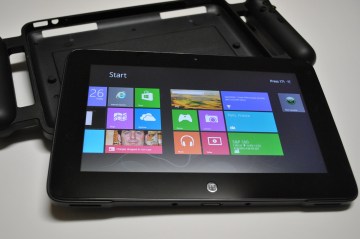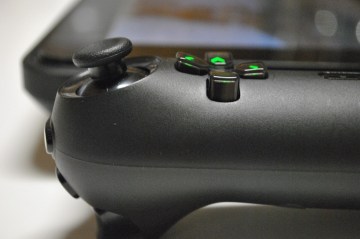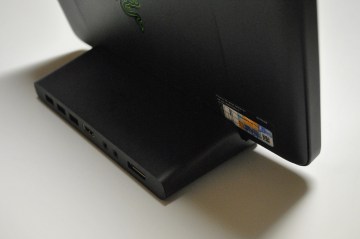For any gamer who’s been kicked out of the living room so the rest of the family can watch TV, the Razer Edge wants to be your dream device.
The Edge is a Windows 8 tablet that runs the latest PC games. It offers attachable game controls, and can also slide into an HDMI dock for playing on a television or desktop monitor. For $1,350 with all the accessories, the Razer Edge is a home video game system, portable console and gaming PC all in rolled into one.
It’s also a glimpse into the inevitable future of “core” gaming, when we’re no longer tethered to a bulky set-top box or PC tower, and we’re able to traipse freely from one screen to the next. But while other firms are experimenting with fancy wireless trickery and cloud-based streaming, Razer tried to deliver the future through brute force, and there are unintended consequences.

Inside, the Edge packs a dedicated NVidia graphics card, a powerful Intel Core i5 processor and 64 GB of storage, at a base price of $1,000 without accessories. (A “Pro” model includes a faster i7 processor, Bluetooth 4.0 and double the storage for $300 more, or quadruple the storage for $450.) The Razer Edge Pro review unit I’ve been testing handled games like Far Cry 3 and Dishonored with more smoothness and fidelity than an Xbox 360 or PlayStation 3.
Not that you could actually play those games on a touch screen. Instead, you can tack on Razer’s $250 Gamepad, which clips onto the tablet like a pair of wings, each with their own thumbsticks, buttons and triggers. Or, you can just plug a wired gamepad or mouse/keyboard combo into the Edge’s full-sized USB port.
The result is a product that doesn’t look or feel futuristic. The Razer Edge is thicker than many thin-and-light laptops and heavier than a first-generation iPad. It has two large vents on the top edge that spew hot air during prolonged gaming sessions, and the bezel around the screen is wide compared to other tablets. The power brick is comparable to that of a full-sized laptop.
Also, the battery life is terrible. On 50% brightness, it lasts through about an hour of game time, and a little under four hours of regular computing.
However unfortunate, these are all necessary compromises. To deliver high-end gaming, the Razer Edge simply needs to run thicker, heavier and hotter than other tablets, and having a dedicated graphics processor always translates to lower battery life.

But the Edge’s other wounds are self-inflicted. For reasons unknown, Razer angled the Gamepad’s thumbsticks away from the player, making them harder to control. And because the face buttons are located directly underneath the sticks, they can be tricky to reach in the heat of battle. Razer needs to rethink the dual-wand design of these controls, and try to hew closer to the shape of existing game controllers. Also, the power cord doesn’t connect strongly enough to the tablet, and it’s prone to popping out when the nearest outlet is on your left side because of how the cable gets pulled the opposite way.
Re-purposing the PC as a portable or home gaming system brings software compromises as well. Some games should theoretically support a gamepad, but don’t. Occasionally you’ll run into the odd DirectX bug, or you’ll have to mess with video settings to get the best performance. The most annoying issue I ran into was a Steam message that popped up while playing Far Cry 3, which required pressing Shift-Tab to dismiss. Seeing as the GamePad has no Shift-Tab button, my only options were to let the message cover up part of the screen or plug in a keyboard to get rid of it.

To be fair, the Razer Edge has its glorious moments. Sitting in bed playing Borderlands 2 was a treat, and being able to transform the system into a home game console is well worth the $100 cost of the HDMI dock. (It also doubles as a handy way to watch Internet video sites like Hulu without paying for a subscription.) It’s also worth noting that because many games on Steam support cloud saves, existing PC gamers can play on their desktops and then pick up right where they left off on the Edge.
Still, despite my initial excitement over the Razer Edge, I didn’t touch the thing for more than a week of my loan period. It wasn’t because I lacked games to play — for part of the time, BioShock Infinite was at the top of my playlist — but because the experience didn’t come close to playing on my desktop PC. I only picked up the Edge again out of obligation, when Razer PR reminded me they’d be needing their review unit back soon, and I felt the need to log more play time.

Now’s the time where I should express hope for a second-generation Razer Edge. An upgrade to Intel’s next-generation processors would bring significant battery life improvements, and in the meantime, Razer could fix the Gamepad’s (literally) sore spots.
But there’s a decent chance that the concept of a high-end gaming tablet will never really work. Integrated graphics are becoming good enough to handle many high-end PC games, without the drawbacks to weight, thickness, heat and battery life caused by a dedicated graphics card. (As some have noted, Microsoft’s Surface Pro already does an admirable job.) Attachable game controls and a docking station are great ideas, though, so maybe Razer can try to bring those accessories to a wider range of tablets.
As for the Razer Edge, several other reviews have dubbed it the Swiss Army knife of game consoles. Unfortunately, this metaphor works two ways: yes, it’s one package that serves many purposes, but the knife doesn’t cut as well, the scissors are tiny, the saw blade is ineffective and the screwdriver can be finicky. If it was cheaper, it could be worth the compromise. Right now it’s kind of like buying a gas station multi-tool at Leatherman prices.

